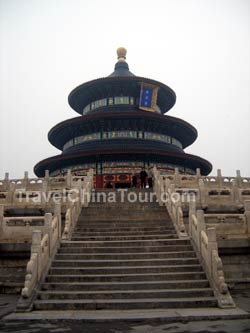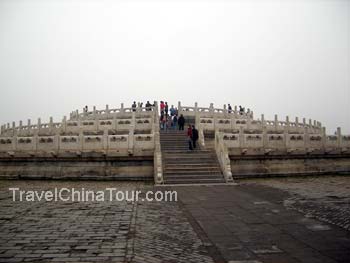The Temple of Heaven is located in southeast Beijing, and it was where emperors of the Ming and Qing dynasties worshipped the heaven and prayed for good harvests each year. It is the largest architectural complex for rituals to pay homage to heaven. 22 Ming and Qing Dynasty emperors held more than 600 ceremonies to worship the heaven here. The last event of heaven worship took place here in 1915. In 1998, the Temple of Heaven was added to the World Heritage List by UNESCO.
The Temple of Heaven covers an area of 273 hectares. The unique design and symbolic layout of the Temple embodies the ancient Chinese ideology of "complete harmony of man and nature." To better symbolize heaven and earth, the northern par of the Temple is circular while the southern part is square, which reflects the ancient Chinese belief that the Heaven was round, and the earth was square.
The Temple of Heaven is divided into the inner altar and the outer altar. The main buildings in this complex lie at the south and north ends of the central axis line of the central altar. At the northern part of the temple is the Qigutan complex (Altar of Prayer for Grain), where emperors sacrificed animals and burnt incense sticks to pray for good harvests. The southern part is the Yuanqiutan complex (Circular Mound Altar), where emperors held ceremonies for worshipping the heaven.
The Temple of Heaven contains other buildings such as the Zhaigong (Hall of Abstinence) where emperors held fasts before the ceremony, and Shengyueshu (Divine Music Hall), an imperial organization in charge of performing music during the ceremonies.
The Qiniandian (Hall of Prayer for Good Harvests) is the core structure of the Qigutan complex. This was where the Ming and Qing emperors held ceremonies to pray for good harvests. It was first constructed in 1420, standing on a round 5.2 meter high white marble base, comprised of 3 tiers. The hall itself is 32 meters in height, covered with blue glazed tiles. There were no beams, crossbeams, or nails used in the construction of the Hall. The structure was supported by 28 massive wooden pillars, and a number of bars, lathes, joints, and rafters, which are integrated into a reinforced frame.

The Qiniandian.
During the first month of spring, ceremonies of praying for good harvests were held in the Qiniandian. The 28 pillars are arranged in 3 rings - the 4 central pillars are 19.2 meters high and 1.2 meters in diameter. The 12 gilded pillars in the middle ring represent the 12 months of the year, and the outer 12 pillars represent the 12 hours of a day (by way of ancient Chinese time counting). These 28 pillars support 3 layers of ceilings.
The Jitiantai (Heaven Worshipping Terrace) is the principal structure of the Yuanqiutan (Circular Mound Altar). Here, emperors offered sacrifices to heaven on the day of the Winter Solstice each year. The Jitiantai is a 3 tiered stone terrace that was first built in 1530. In 1749, under the reign of emperor Qianlong, the terrace was expanded, which has lasted till today.

The Heaven Worshipping Terrace at Temple of Heaven
This Temple of Heaven Worshipping Terrace is representative of ancient Chinese stone structures. It is 5.17 meters high, consisting of 3 stone tiers. The upper terrace 23 meters in diameter. At the center of the top tier is a round stone surrounded by 9 concentric rings of stones. The number of 9 was regarded as the symbol of heaven in ancient times. The Heaven Worshipping Terrace is surrounded by 2 walls. The inner wall is round and 102 meters in diameter, symbolizing heaven, while the outer wall is a square shape 168 meters in length symbolizing earth.
Read more about Temple of Heaven in part 2. |